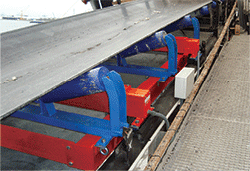Conveyor belts
are a ubiquitous feature in most industrial facilities and for many good
reasons. Since the invention by Richard Sutcliffe in the early 1900s, these systems have continued
improving efficiency in factories by enabling automation of material movement.
They also help in space maximization while also reducing your labor and energy
costs.
One of the features that helps optimize these
systems is a conveyor belt scale. These help to
measure the material load as it travels over the belt. This is possible because
as material moves down a conveyor belt it exerts a force proportional to the
material load.
However, the fact that the scale is out of
sight leads to neglect which in turn affects its accuracy of capabilities. Like any other system involved in handling
materials the need for maintenance cannot be gainsaid. When
bulky materials are involved the problem is exacerbated thus calling for
regular checkups and proper maintenance to avoid inaccurate measurement.
An ideal scale will provide weight results
that tally with those provided by National Institute of Standards and
Technology (NIST)’s Handbook. While most products in the market offer accuracy
guarantee it is important to note that simple maintenance ensures the
capability of the scale is not compromised.
As a facility owner, you need to understand
the main installation and maintenance guidelines in order to care for the belt
scale as per required standards.
Main Installation Tips
According to industry experts most scales are
affected by poor installation. Lest you fall into this pitfall consider some of
these tips to get the most out of your scales:
Correct Positioning
This is one of the greatest factors which
determine the functionality of the scale. You must ensure the scale is
positioned where there is minimal tension and consistence. The best position
according to National Type Evaluation Program
(NTEP) is close to the tail section and you should ensure the scale is
positioned on rigid mountings.
The position
should also be away from machines that might cause vibrations as this will
affect the scale readings. Extensive even horizontal stretches are the best but
with the right positioning of idlers even a slope can do. For convex belts the
best location should be 12 m to the retreat side and 6 m on the approach side.
For convex belts minimum distance from the tangent points of the curve is 12
meters. It is also important to avoid placing the scale too close to the feeder
because the material will not have loaded.
Minimize Variable Belt Tension
Over time, belts
tend to sag due to temperature variation and the load. Such variations in tension will affect the
scale and hence a gravity take-up is recommended. This helps to reduce the
impact of tension of the slack on the belt. The take-up, however should move
freely and consistently place tension on the belt. At the same time you should
not overload the belt because not only will this affect the scale but also the
belt.
Idlers Alignment
Idlers determine
how well your scale will function and they should be precisely positioned. Two
idlers should be aligned on both sides of the scale. For higher accuracy levels
you can use more than two idlers. To align precisely use a wire over the roller
edges and tighten until you are sure there is no slacking. Work on the rollers
until you are sure they are even. It is important to only use idlers of the
same size, shape, make and style for easy alignment. The idlers also need to be
scaled at equal distances.
Leverage Speed sensors
Speed is another
important determinant of the accuracy your conveyor belt scale gives. Sensors should be
attached to the tail pulley or alternatively the bend pulley shaft where the
connection cannot slip. Mounting of a speed sensor should also be on a solid
face pulley. If you use wheel driven speed sensors that are used with the return
strand of the belt place them close to a return idler. This guarantees a stable
drive surface to guarantee accuracy.
Optimize Your Wiring
Speed sensors
are susceptible to radio frequency interference and when wiring the unit ensure
you follow instructions to avoid inaccurate scale readings. Use shielded cable, grounded metal conduit
and terminal blocks throughout the circuit to avoid such interference.
Invaluable Maintenance Tips
The way you care
for your belt scale determines
its efficiency and life. The question
that comes to mind is where do you start? Well, here are some highlights:
General
maintenance: Your scale needs to be cleaned regularly and lubricated. You also
need to keep a lookout for any slack in tension and also alignment. The belt should
be trained to stay on course while extreme loading must be avoided. Belt
scrapping also helps you to get ideal readings.
Belt
calibration: Determinants in this crucial maintenance
procedure of conveyor belt include its condition, seasonal temperature
changes, prior maintenance, and expected accuracy. It is advisable to start
with a small calibration interval after installation as you learn how badly the
scale is deviating. You can later increase the calibration intervals if you
find a large deviation from the accuracy you desire. Speed tests, zero tests,
span tests must be carried out during calibration.
Weather factors:
Temperature shifts are the worst nightmare when dealing with scale maintenance.
You can avoid gravity tensioning device to mitigate effects of temperature
changes.
Your belt scale
is an invaluable part of your business. To enhance your scale’s efficiency
follow these tips and always remember they are there, lest you forget to
maintain them religiously.

